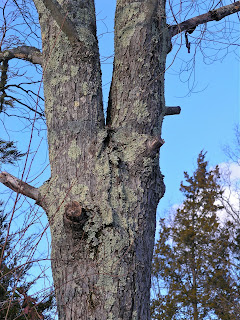
When I looked above her - dang, there was yet another tree with its bark hanging off. If you're new to this blog and have no idea what I'm talking about, click here first.


After that I took a little detour from my usual route, down a quiet dirt road, one of the few unpaved remaining in this area.


The snow and sky were a rare and stunning sight, but the pine trees...not so much, they are all in various stages of thinning.


This is another location, like along Black River Road, where it is plain to see that palatial homes which were once discretely sequestered behind healthy stands of trees and underbrush are now visible from the public byways.


But the trees in his hedgerow are falling like dominoes, I suppose high walls will be the next recourse.


Here's another beautiful, formerly private home. Many of these trees are actually pines - but without their needles, and teeming crowded understory, the house is visible. Soon the handsome large conservatory on the right will be clearer to view.


Here's the approach to yet another magnificent home. This enchanting estate belongs to the heirs to the oldest tobacco company fortune in the United States.


Shortly beyond it, I came upon the former dairy farm which is now the headquarters of the Upper Raritan Watershed Association. Their mission, according to their website, is "...to ensure the protection of the natural resources of the Upper Raritan Watershed through education, advocacy, land preservation and stewardship."
In light of that, particularly the "advocacy" part, I wrote some time ago first to staff, and then to members of the Board of Directors, asking them what URWA is prepared to do about the fact that the vegetation in the watershed they are pledged to protect is dying off with mind-numbing rapidity. Well, I got no answer from any of them and so I figured, things must be just dandy over there. But oops I discovered, not exactly.

In light of that, particularly the "advocacy" part, I wrote some time ago first to staff, and then to members of the Board of Directors, asking them what URWA is prepared to do about the fact that the vegetation in the watershed they are pledged to protect is dying off with mind-numbing rapidity. Well, I got no answer from any of them and so I figured, things must be just dandy over there. But oops I discovered, not exactly.

You have to wonder what they are thinking when they look at their own headquarters, never mind the rest of the watershed.


Here's one of the larger trees that remain, a maple with it's bark turning black, and peeling away from the limbs.


I have been writing to many people - scientists, government agencies, publications, and environmental groups. I wrote to members of my own township government to ask what we as a community should do to save our ecosystem, and not one of them answered either.


Sights like this white pine trunk in the center, which hasn't got a single needle on its branches, are making me feel fierce and furious about our so-called leaders. I'm referring to people who have declared their commitment to serve their community, either as paid staff or volunteers or elected officials, and yet the most important challenge we face to the very existence of our civilized society, they prefer to ignore. Instead of protecting our precious habitat they instead are presiding over its destruction.


This tree looks like the apple tree in the Wizard of Oz, the angry one that talks and started throwing fruit. If this one could talk, it would say in very rude language that the directors and staff of URWA, and the Tewksbury Township committee members, and the entire US and state level Environmental Prostitution Agencies and the Department of Environmental Prostitution and the liars at the Department of Agriculture should either start doing their jobs or resign in disgrace.


Oh but what will they do? Why, they'll plant baby trees like this maple. Notice it still has leaves clinging to the branches. That's because in the autumn, leaves don't simply fall off. There is a process where the tree actually pushes them off, and that takes energy. This sapling didn't have the energy, and it's not going to leaf out next spring.

















Gail,
ReplyDeleteYour photoessays are terrifying and terrific!
Things seem worse there than here in MA, but we see the same types of things. Why don't others see? I think it's because of "inbox thinking." This isn't in any of the books or papers (unless you really look hard, as you have done). Please keep up your vital work. Certainly if we knock loud enough more will wake up and help spread the needed alarm!
Roger; www.gwenet.org
Thank you Roger for your encouragement! I went to a Christmas tea last week and to my astonishment a perfectly normal nice lady I had never met before agreed with me completely. She said she had two very large maples in her yard. One was just taken down - she said she watched it die in 6 months time, and the other is soon to follow.
ReplyDeleteI guess that's when people will realize what is happening to our trees - when they either see them fall down or have to spend a lot of money having them felled. Soon - if not already - the insurance companies and power companies will see it reflected on their books.
Have a wonderful and happy holiday!
In the last photo -- are those cones, or galls from insect borers?
ReplyDeleteI suspect borers in a lot of those cases -- but it may be a fungus.
Go to the Arbor Day Foundation site, search for "tree decline," and you'll get a page of suggestions for what to do.